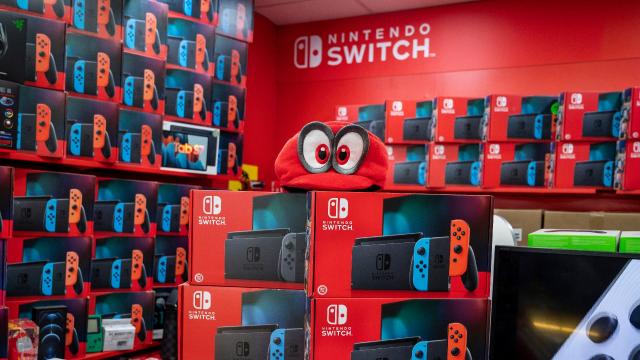Today, in its annual earnings statement, Nintendo cited the ongoing chip shortage as a reason for a precipitous annual dip in Switch hardware sales…while in the same breath saying it hit company targets. Well, technically.
Over the course of Nintendo’s fiscal year 2022, which started last April and ran through the end of this past March, the company sold 23 million Switch consoles, a 20% drop from the prior year. That stat, by the way, is tallied across all three iterations: the standard edition, the handheld-only Lite, and the snazzy new OLED model, which was released last October.
In a vacuum, 23 million is an eye-popping figure, but it’s also a case of moving goalposts. Initially, Nintendo set itself the goal of selling 25.5 million Switch consoles over the course of its 2022 fiscal year. In November, the company reduced that figure to 24 million, before reducing it again, in February, to 23 million, which it passed by 60,000. To date, the Switch has sold 107 million units — more than the Wii (101 million) but still far less than the Nintendo DS (154 million).
For its forthcoming fiscal year, Nintendo has forecast some more conservative estimates, despite having just proven that it can move some numbers around a spreadsheet with very little ramification.
“Taking into account factors such as constraints in the supply of semiconductor
components, we forecast sales for Nintendo Switch hardware to be 21 million units [for fiscal year 2023],” the company wrote in a companion document to today’s earnings report. “The consolidated earnings forecast is made under the assumption that we are able to manufacture the products in accordance with our sales plan. However, manufacturing and logistics may be impacted by factors such as obstacles in the procurement of parts including semiconductors, and risks associated with COVID-19.”
It’s unclear whether or not the long-rumoured “Switch Pro” — a supposed luxe upgrade of the hybrid machine capable of running games at 4K resolution — plays a role in that forecast. But if pressures stemmed from the semiconductor shortage are already impacting the standard, don’t bet on it. (Experts believe the semiconductor shortage could extend into next year.) Representatives for Nintendo did not immediately respond to a request for comment.
Even so, the Switch is outselling the competition. By the end of 2021, Microsoft had sold an estimated 12 million Xbox Series X and S consoles, which were first released in November 2020. Experts put figures for Sony’s PlayStation 5, also released in November 2020, at around 17 million. Both figures have no doubt been affected by the chip shortage, though, which has made finding next-gen consoles a pain in the arse. (Sony reduced its own sales expectations for the PS5 in February, citing the chip shortage.) As the NPD Group’s Mat Piscatella noted on Twitter, the Switch “sold the most units of hardware” compared to its competitors during the first quarter of this year.
Last month, workers at Nintendo of America filed a complaint with the National Labour Relations Board, alleging a litany of employment malpractices, including surveillance and retaliation — all of which was detailed further in a Kotaku report. Meanwhile, a former supervisor at a Joy-Con repair facility spoke to Kotaku about a deluge of overwork and poor conditions.
